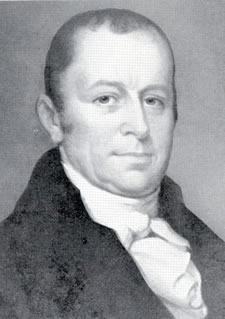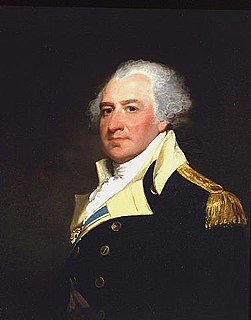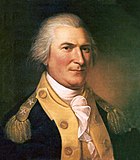
The Governor of the Commonwealth of Virginia serves as the chief executive of the Commonwealth of Virginia for a four-year term. The current holder of the office is Democrat Ralph Northam, who was sworn in on January 13, 2018. His term of office will end in 2022.

Simon Snyder was the third Governor of the Commonwealth of Pennsylvania, serving three terms from 1808 to 1817. He led the state through the War of 1812.

Milton Jerrold Shapp was the 40th Governor of the U.S. state of Pennsylvania from 1971 to 1979 and the first Jewish governor of Pennsylvania. He was also the first governor of Pennsylvania to take advantage of an amendment to the state constitution lifting the ban on state governors succeeding themselves in office and authorizing them to serve a maximum of two consecutive terms at a time, while still requiring a minimum of four years out of office between any two such consecutive terms.

The Lieutenant Governor is a constitutional officer of the Commonwealth of Pennsylvania. The lieutenant governor is elected for a four-year term in the same year as the governor. Each party picks a candidate for lieutenant governor independently of the gubernatorial primary. The winners of the party primaries are then teamed together as a single ticket for the fall general election. Democrat John Fetterman is the incumbent lieutenant governor. The lieutenant governor presides in the Senate and is first in the line of succession to the governor; in the event the governor dies, resigns, or otherwise leaves office, the lieutenant governor becomes governor.

The 2010 Pennsylvania gubernatorial election was held on November 2, 2010, to elect the Governor and Lieutenant Governor of Pennsylvania, concurrently with elections to the United States Senate in Pennsylvania and other states and elections to the United States House of Representatives and various state and local elections.

The Pennsylvania gubernatorial election of 2002 was held on November 5, 2002, and included the races for the governor and lieutenant governor of Pennsylvania. Incumbent Republican Governor Mark Schweiker, who became Governor in 2001 when Tom Ridge resigned to become Homeland Security Advisor, was eligible to run for a full term, but did not do so. Democrat Ed Rendell, the former Mayor of Philadelphia and Chairman of the Democratic National Committee, emerged from a competitive primary to win the general election against Republican Pennsylvania Attorney General Mike Fisher.

The Pennsylvania lieutenant gubernatorial election of 2010 was held on November 2, 2010. The winning candidates for Governor and Lieutenant Governor will serve a four-year term from 2011 to 2015. In Pennsylvania, the Lieutenant Governor is elected on the same ticket as the Governor, so the only campaign for this office was the primary election. As a result of Tom Corbett's election to the position of governor, Jim Cawley became the new Lieutenant Governor.

James Cawley is an American politician who was the 32nd lieutenant governor of Pennsylvania, from 2011 to 2015. A Republican, he previously served on the Board of Commissioners of Bucks County, Pennsylvania.

The Pennsylvania gubernatorial of 1860 was held on October 9, almost one month before Presidential election. Andrew Curtin of the newly formed Republican Party won the governor's mansion over Democrat Henry Donnel Foster.

The Pennsylvania lieutenant gubernatorial election of 2002 was held on November 5, 2002. In Pennsylvania, the Lieutenant Governor is elected on the same ticket as the Governor, so the only campaign for this office was the primary election.
The President pro tempore of the Pennsylvania Senate is a constitutionally-created office in the Commonwealth of Pennsylvania. The incumbent holder of the office is Republican Joe Scarnati.

The Pennsylvania gubernatorial election of 1811 occurred on November 5, 1811. Incumbent Democratic-Republican governor Simon Snyder won re-election over Federalist candidate William Tilghman, the Chief Justice of the Pennsylvania Supreme Court, by a wide margin. Two of the major policy goals on which Snyder campaigned were increasing spending for infrastructural upgrades and authorizing the transfer of governmental operations from Lancaster to Harrisburg.

The Pennsylvania gubernatorial election of 1796 occurred on November 8, 1796. Incumbent Democratic-Republican governor Thomas Mifflin successfully sought re-election to a third term. For the second consecutive election, he was victorious over U.S. Representative Frederick Muhlenberg, the Federalist candidate, by a wide margin.

The Pennsylvania gubernatorial election of 1793 occurred on November 5, 1793. Incumbent Democratic-Republican governor Thomas Mifflin successfully sought re-election to another term, defeating Federalist candidate and U.S. Representative Frederick Muhlenberg.

The Pennsylvania lieutenant gubernatorial election of 2014 took place on November 4, 2014, to elect the Lieutenant Governor of Pennsylvania. In Pennsylvania, the winners of the lieutenant gubernatorial primary elections join the ticket of their party's gubernatorial nominee.

Michael J. Dunleavy is an American politician who is the 12th governor of Alaska, serving since December 2018. A Republican, Dunleavy was a member of the Alaska Senate from 2013 through 2018. Dunleavy defeated former Democratic United States Senator Mark Begich in the 2018 gubernatorial election.














